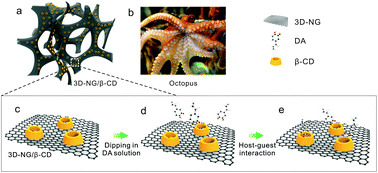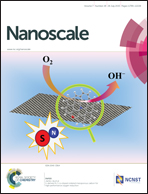3D nitrogen-doped graphene/β-cyclodextrin: host–guest interactions for electrochemical sensing†
Abstract
Host–guest interactions, especially those between cyclodextrins (CDs, including α-, β- and γ-CD) and various guest molecules, exhibit a very high supramolecular recognition ability. Thus, they have received considerable attention in different fields. These specific interactions between host and guest molecules are promising for biosensing and clinical detection. However, there is a lack of an ideal electrode substrate for CDs to increase their performance in electrochemical sensing. Herein, we propose a new 3D nitrogen-doped graphene (3D-NG) based electrochemical sensor, taking advantage of the superior sensitivity of host–guest interactions. Our 3D-NG was fabricated by a template-directed chemical vapour deposition (CVD) method, and it showed a large specific surface area, a high capacity for biomolecules and a high electron transfer efficiency. Thus, for the first time, we took 3D-NG as an electrode substrate for β-CD to establish a new type of biosensor. Using dopamine (DA) and acetaminophen (APAP) as representative guest molecules, our 3D-NG/β-CD biosensor shows extremely high sensitivities (5468.6 μA mM−1 cm−2 and 2419.2 μA mM−1 cm−2, respectively), which are significantly higher than those reported in most previous studies. The stable adsorption of β-CD on 3D-NG indicates potential applications in clinical detection and medical testing.


 Please wait while we load your content...
Please wait while we load your content...